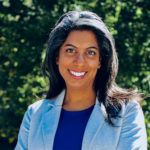BY Bina M. Patel
CEO, Saathi Impact Consulting
and TFN PLACES Alum
Bina Patel is an alum of TFN’s PLACES fellowship, a year-long leadership development program for professionals in philanthropy to better understand issues of race, equity and inclusiveness — and to then translate those skills and knowledge in to their grantmaking practices. She currently serves as a facilitator for the PLACES fellowship cohort, which is conducting its learning virtually this year. This post originally published on the Saathi Impact Consulting blog.
On a recent webinar, as the pandemic sealed us off in corners of bedrooms and makeshift home offices, the check-in question of the day was “How is this moment changing you?”
Suddenly, I was struggling, feeling tears well up at my exhaustion, of the overwhelming nature of recent events, the current uncertainty. And when I dug a bit more deeply I confronted the depths of my own rage at the unrelenting racism we witnessing every day, the abuses of power that go unchecked from our leaders, and the inequality that has been exasperated by the pandemic. I was overwhelmed — trying to take in the ever extreme range of the rollercoaster feelings I was feeling. I was uncomfortable with these new corners of rage I was holding. I almost didn’t recognize myself.
At the edges of this darkness was a glimmer. I saw at the jagged ends of my grief and exhaustion a glimmer of truth: this moment was making me more radical. I didn’t say it out loud, but I saw it. I could feel it, this truth sitting at the edges of my overwhelm, patiently waiting.
To get to a place of new truth-telling and edge walking, of embracing the radical, I had to lean into the new kind of rage and outrage, not shrink from it. I had to expand to hold more of all of the feelings, expand to be able to hold the pain and rage, while also being able to function and be purposeful – to show up and do my job, and to still be able to take care of myself.
This wasn’t the first time I felt this way. Not too long ago I stood on the land of the Sioux Nation at Standing Rock and listened to Elders, endured meetings full of “Karens”, and had to shield myself from the macro-aggressions (*there is no such thing as microaggressions.) I had sat at immigration court and watched the proceedings of asylum seekers, stood at the border wall watching CBP, attended the funerals of black young men killed by police, observed policymakers make budget decisions with little regard to the humans affected, watched the news of the 2016 election, etc, etc, etc. This wasn’t the first time and it of course won’t be the last.
I knew that this outrage needed some movement – some way out of being labeled “outrage.” It cannot be in vain and it can’t take me out of my purpose.
For outrage to be righteous and rooted it must be of service to the collective.
To be of service, I had to resist the urge to shrink, to let it eat me up. I had to undo feelings of shame because some folks think outrage is too much, too unwieldy. I had to undo my own feelings of defeat because I had internalized that outrage meant I was failing to show up with love.
How could I be an ally, agitator, change agent, strategist, speaker, coach, and co-conspirator if I didn’t feel outraged? How could I do the work of justice, equity, and inclusion if I rejected feeling pain and outrage?
Read the full post here.
About the Author

Bina M. Patel is the CEO of Saathi Impact Consulting, which partners with philanthropic, nonprofit, and social innovation organizations to advance justice, belonging, and equity. She is an alum of the PLACES 2012 Cohort. To learn more about Bina’s journey as a PLACES alum, visit our PLACES X: Stories of Impact series.
Feature image photo credit: Biansho | Dreamstime.com
